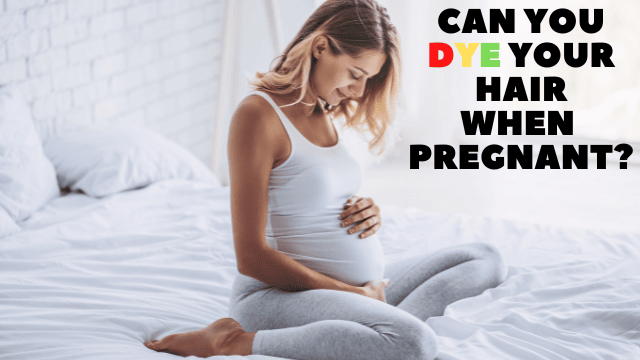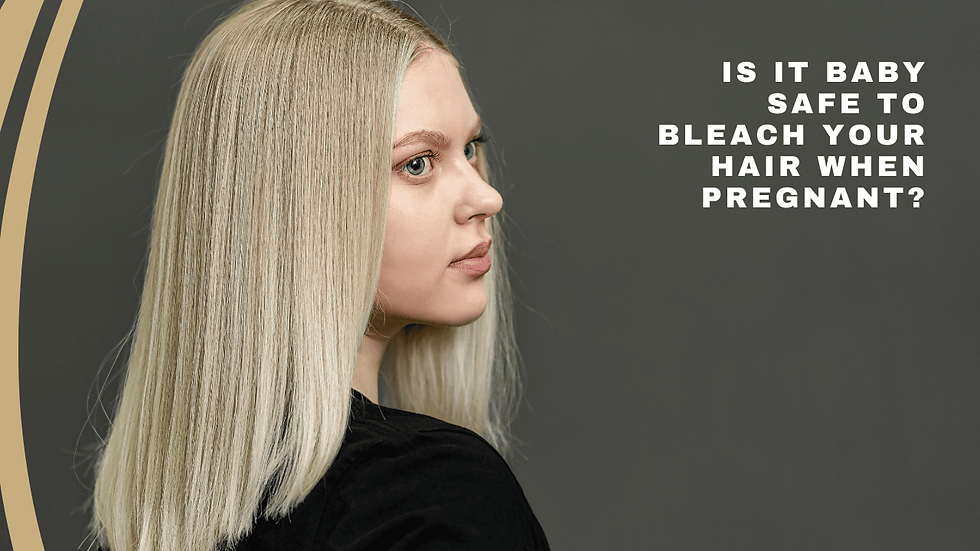The majority of evidence, indicates that coloring your hair while pregnant is safe. According to certain research, the chemicals included in hair colors may be harmful in very high concentrations. In contrast to the extremely little amounts of chemicals you could be exposed to when coloring your hair, these dosages are enormous.

Is using hair color while pregnant safe?
Despite the paucity of research on the matter, many professionals advise expectant moms to hold off until the beginning of the second trimester. According to a study done between 2017 and 2019, there was no connection found between pregnant women who dyed their hair at any stage throughout their pregnancies and overall neonatal issues. Additionally, it didn't appear that dyeing hair while pregnant had an effect on infants' apgar ratings, which are used to assess newborns' general health soon after birth. To draw any conclusions, the research did note that "additional data taking into account the chemical compounds in the hair dyes, exact duration of hair coloring, and other variables related with premature delivery is needed.
When Should You Not Dye Your Hair During Pregnancy?
After approximately a month, you could be prepared to reach for the bottle (of hair colour, that is). Your hair may be growing quicker than before and may even have a different texture and color than usual due to the pregnant hormones coursing through your body.

However, your baby's first 13 weeks are a crucial period for development: Organs are beginning to take shape, muscles and voice chords are developing, and nail beds and hair follicles are beginning to form. Even if you don't absorb a lot of the chemicals in hair color and there isn't any concrete proof that those chemicals are truly bad for your unborn child, why take the chance?
If your doctor gives the go-ahead for you to schedule an appointment at the salon, you might want to think again about the service you choose. Single-process color is applied to the hair and scalp, where the pores in your skin soak up the chemicals, which can enter your bloodstream. Root touch-ups and a root-to-tip color change fall under this category.
How to apply the colors when pregnant
Try coloring your hair directly on the shaft using methods like highlights, lowlights, frosting, and streaks for a safer alternative. A less popular but no less secure approach involves pulling hair through a hat before coloring it. This is because the cap conceals the scalp.

The kind of coloration you employ should also be taken into consideration. Discuss gentler choices with your hairdresser, such as color with an ammonia-free base.
Consider a semi-permanent color if you're more of a do-it-yourselfer; it doesn't include ammonia and normally doesn't contain peroxide (bleach). Additionally, it fades gradually after a month or two and is more forgiving than permanent dyes.
Other less hazardous at-home options include vegetable and henna dyes, but always read the label before purchasing. Certain purportedly "natural" methods use the same amount of chemicals as their conventional counterparts.
Experts concur that you should take additional safety precautions when coloring. Ask to be seated in a well-ventilated location if you're in a salon.
Open the windows if you're at home so you're taking in fresh air rather than dangerous pollutants. If you're using the product on your own hair, always use gloves and put on a long-sleeved shirt for further protection. Follow the manufacturer's instructions, let the dye on for the shortest amount of time advised, and be sure to properly wash your scalp after the process is over.
Is it baby safe to bleach your hair when pregnant?
The tiny quantity of color that makes its way into your scalp is unlikely to have any impact on the developing fetus. Although there has only been a small amount of study on hair dyes and other treatment chemicals during pregnancy, the majority of it suggests they are generally safe to use.

Being pregnant may cause bleach to harm your hair significantly intensely than usual. Bleaching puts a big burden on your hair regardless of your present hair condition, and paired with pregnancy, it may contribute to substantial hair breakage and loss," says the American Pregnancy Association. "Women's bodies absorb fewer nutrients for hair, nails, and teeth during pregnancy."
How to bleach your hair safely during pregnancy tips for you?
There are steps you may do to lessen the chance that any chemicals can harm your baby if you bleach your hair at home. You might wanna::
Put on gloves
The bleach on for the least amount of time recommended on the box.
Make sure the room is well aired by opening the windows.
After applying the bleach, rinse your hair.
Always follow the manufacturer's advice on the box's directions
Do a strand test every time you bleach your hair (use the instructions that the manufacturer has on the box or speak to your hairdresser for advice)
wait until after the first 12 weeks of pregnancy, when there is far less chance that toxins can harm your unborn child.
Instead of a complete bleach, simply do the highlights
Can I dye my hair at 12 weeks pregnant?
Your fetus has fast growth and development throughout the first trimester. The brain and spinal cord are among the important organs that are developing. Wait till this crucial time is through before using hair color if you want to be careful (and sleep better at night).
To be safe, many physicians advise waiting until week 13 of pregnancy before changing your hair color. Because why risk it?
Consult your doctor before dyeing your hair if you have eczema, psoriasis, or any other skin disease.
These disorders may lessen part of your skin's protection and result in minor skin cracks. If you have a skin issue, hair color may potentially irritate or sensitize you more.
In order to reduce your likelihood of experiencing any unexpected responses, stick with the hair coloring you've previously used.
.png)
Comments